Introduction
The proposed study will focus on investigating marketing methods for Tesla to help it survive in the market for its new technology products. While automobiles have been marketed for more than a century, Tesla offers a radical disruptive, plug-in electric vehicle that matches the performance of conventional fuel vehicles, such as diesel and petrol vehicles. The marketing channels, the marketing mix, and integrated marketing communication methods will be analysed to indicate the best methods that Tesla can use to sell its electric vehicles. This research will use a mixed-method approach with primary and secondary research.
Background
Tesla Inc. is a manufacturer of electric cars, energy storage products, and solar panel manufacturer based in Palo Alto, California, in the US. The main promoter of this firm is Elon Musk who is also the CEO of Space X and the chairman of SolarCity Corporation. Tesla became famous after the launch of the Model S, a plug-in electric car that had the performance in speed and acceleration of petrol-fuelled cars. Subsequently, Tesla introduced the Model X, and Model 3 cars (Tesla 2017). The latest Model S achieves an acceleration of 0-60 miles per hour in 2.9 seconds and can run for 335 miles on a full charge, with seven passengers. Achieving a full charge takes about nine hours, and the electricity cost for a full charge is about $12/ hour. With the awareness of pollution caused by diesel and petrol cars, electric vehicles are increasingly in demand (Models 2017).
Over the years, several automobile manufacturers, such as General Motors, Ford and others, have offered fully electric vehicles. Sales were low, however, since these models had low performance. The market changed with the introduction of Tesla cars in 2012, which were very well received (Bartlett 2017). The Model S saw sales of 150,000 units by November 2016, and the Model X, which was released in July 2017, saw sales of 250,000 units. The basic version of the Model X starts at $80,700, while a fully loaded version costs more than $100,000. The basic version of Model 3 is $36,000 while the Model S costs $69,000 (Car & Driver 2017). There are plans to introduce lower-end models and customer satisfaction stands at 91%, which is a high score (Kane 2017).
These indicators mean that Tesla has a secure future. The problem is in the high debt of $6.8 billion that Tesla has accumulated. In addition, development costs for Tesla cars are high and marketing costs are presently about $2 billion, turning the firm into a negative cash flow entity. To break even by 2020, Tesla has to sell more than 2 million units per year, and customers must buy several add-in features worth at least $10,000 per car (Jones 2017). Unless Tesla achieves these sales, it is likely that the firm will close down and declare bankruptcy. The target segment for Tesla cars includes affluent people who are environmentally-conscious, and who are willing to pay the premium price (Lambert 2017). Aggressive marketing and promotion methods are needed with the optimum segmenting, targeting and positioning techniques in the appropriate marketing channels. With this background, this paper presents a proposal to examine marketing techniques to increase the adoption rate of Tesla cars.
Justification of the Research
The US car market is very competitive with a number of leading automotive manufacturers such as Ford, Toyota, Honda, BMW, Chrysler, GM, and others, manufacturing and selling cars. In 2017, more than 7.1 million units were sold, and the total revenue was $715.85 billion. Electric plug-in cars saw encouraging growth and in 2016, US sales grew to 570,187 units. However, these vehicles represent less than 1% of the total sales. Hybrid vehicles have also experienced strong growth. A hybrid car runs on diesel or petrol fuel and has an additional electric motor drive, which runs the vehicle on highways, reducing carbon emissions. These hybrid vehicles compete with plug-in electric vehicles (Statista 2017).
A number of well-established car manufacturers offer electric vehicles. Some popular models are the Chevrolet Volt, a plug-in hybrid, the Nissan Leaf, BMW’s 330e and 740e iPerformance vehicles, the Toyota Prius Prime, the Chevrolet Bolt EV, the Mercedes-Benz C 350e Plug-in Hybrid, the Kia Optima PHEV, Hyundai’sIoniq Electric, the Audi Q7 e-tron Quattro, the Jaguar I-Pace, Porsche’s Mission E, and several others. These models fall in the range of affordable cars that compete with the Tesla Model S and premium luxury cars, which compete with the Tesla Model X. Almost every global automotive company offers plug-in or hybrid vehicles. These cars have good sales rates and sell more than 50,000 units (Cazzola 2017). The Tesla Model X outperformed its rival Audi SQ7 and Range Rover Sport in road tests. However, the latter two models are in the $85,000 range, while the Model X costs more than $100,000 (Barry 2017). Many cities and offices have installed direct current fast charging (DCFC) units where these vehicles can be charged. Availability of these charging units and the capability for fast charging is important to drivers.
Another aspect is that large automotive manufacturers sell a large number of conventional fuel vehicles, which provide them with sufficient revenue and economies of scale. As a result, these firms can absorb the cost of research and development without financial breakdown. This is not the case with Tesla, which must obtain minimum sales of a limited line to remain viable. Another issue is that the major firms can outsource the motor, electric drive, battery, and other components, thus reducing their overhead. Tesla, on the other hand, manufactures all its components in-house, considerably adding to costs. Therefore, Tesla operates in a market dominated by major automakers who want to have a presence in electric plug-in and hybrid vehicles since they are a future growth area. It appears that Tesla does not have a competitive advantage over its rivals (Wood 2017).
The justification for this paper is as follows. The previous paragraphs show that the market for electric plug-in and hybrid vehicles is rapidly growing. A number of leading automotive manufacturers have entered the market and offer high-performance cars. It is essential to develop innovative marketing strategies to help Tesla succeed in this competitive market.
Literature Review
The literature review will bring out important topics, such as the marketing forces, diffusion of technology and user adoption, and marketing of hi-tech, innovative products as they relate to electric plug-in and hybrid vehicles and Tesla.
SWOT Analysis of Tesla
A SWOT analysis helps to identify the impact of internal or micro forces on a firm and its product. The analysis helps to formulate a firm’smarketing plan (Hollensen 2015). The four forces that make up the SWOT analysis are strengths, weaknesses, opportunities and threats. As for Tesla, a SWOT analysis reveals the following:
- Strengths: Strong products – Tesla cars are valued for their performance, brand identity, and charisma. The firm has managed to gain quick popularity in a few years.
- Weaknesses: Tesla cars are more expensive than equivalent rival models. Tesla faces a huge debt burden, and future development, marketing expenses, and viability are under threat.
- Opportunities: Tesla needs to enter new markets in China and Japan, where electric vehicles are in demand. It needs to focus on upper-class business people, executives, and celebrities who are environmentally conscious.
- Threats: Tesla faces threats from established, global automotive firms that have introduced similar types of electric plug-in and hybrid vehicles. The firm needs to undertake segmentation, targeting and positioning study, and develop a unique value proposition that will attract the target segments.
PESTLE Analysis of Plug-in Cars
A PESTLE analysis is used to understand the macro or external forces that act on an industry and a firm (Barney 2014). The six forces (political, economic, social, technological, legal and environmental) are analysed for Tesla as follows (Tesla 2017).
- Political: Political support is strong for plug-in electric cars since they are green and have zero emissions. Governments provide subsidies and charge lower taxes for these cars.
- Economic: Global markets have yet to recover from the economic recession and spending is subdued. However, luxury and premium high product sales have increased. Therefore, affluent people have funds to buy expensive plug-in electric and hybrid cars. Operating costs are lower, which is an attractive feature.
- Social: With increased awareness of limiting pollution, reducing carbon footprints, and saving the environment, electric vehicles are gaining in popularity. Tesla and other car models are attractive, show good performance, and are popular. Driving one of these environmentally-sound vehicles makes a person socially acceptable and admired.
- Technological: Tesla cars use high levels of technology in the engine, transmission, and accessories. New models are introduced regularly and innovation levels are high.
- Legal: Patent protection is poor in the industry and innovators often see their ideas used by other auto manufacturers.
- Environmental: With increased concerns to save the planet from carbon emissions and excessive fossil fuel consumption, electric vehicles have gained in popularity.
Porter’s Five-Forces Analysis
Porter’s Five-Force analysis helps to understand the severity of competition and the strength of entry barriers in a market (Porter & Heppelmann 2015). The five forces are threat of new entrants, the threat of substitutes, the bargaining power of customers, the bargaining power of suppliers, and industry rivalry. These factors for Tesla’s electric plug-in vehicle are discussed below (Tesla 2017).
The threat of new entrants: if the returns and growth prospects are high, then the industry will attract new entrants. Electric plug-in vehicles are considered the future of transportation. With depleting reserves of fossil fuels and increased concerns about carbon emissions, many automobile manufacturers have entered the market for electric vehicles. Success depends on cost advantage, economies of scale, cost of production and sales, quality, product appeal, brand identity, and price. Large automotive manufacturers find it easier to enter and consolidate the market since they have extensive supply chains of vendors and dealer networks. Therefore, the threat of new entrants for Tesla is high.
The threat of substitutes: Electric plug-in cars face the threat of substitute products such as conventional and petrol cars, solar-powered cars, natural gas-powered cars, and hybrid vehicles. Electric vehicles face threat from these products when the issue of green and zero-emission is considered. The threat of substitute products is medium.
Bargaining power of customers: Customers have a choice in the range of models, features, and price. Customer loyalty for electric vehicles is not clear and data is not available to determine if owners of fossil fuel car will switch brands when they consider an electric vehicle. The bargaining power of customers is high.
Bargaining power of suppliers: These entities supply parts to manufacturers. Suppliers are selected as per their quality standards and ability to scale operations. Replacing a supplier is cumbersome, but possible since firms have multiple suppliers for each part. Therefore, the bargaining power of suppliers is low.
Industry rivalry: As indicated in the previous sections, the automobile market is very competitive. A large number of global brands compete in product features and price. The same pattern is seen in electric vehicles and Tesla faces great competition. Therefore, industry rivalry is severe.
Summary of the Analyses of the Marketing Forces Models
The SWOT, PESTLE and Five-Forces analyses have brought out some important points, and these are explained as follows. The SWOT analysis indicates that Tesla has a strong product line, the cars are popular, trendy, and have good performance. Pricing may be a deterrent and opportunities exist among the upper class of environmentally conscious consumers. Tesla faces competition from global car manufacturers who have lower overhead costs and well-developed networks. The PESTLE analysis shows strong political support and sustained consumer interest since electric vehicles are environmentally friendly with zero emissions. The Five-Forces analysis indicates that the intensity of competition is severe, that it is a buyer’s market, and substitute products are available. The marketing strategy will need to consider these issues.
Consumer Behavior and Buying Intentions
The purchase of electric vehicles is subject to customer preferences and buying behaviour patterns. Monitoring buying behaviour and consumer behaviour helps to understand the manner in which customers react to a product, the stimulus they perceive from advertisements, and their behavioural intentions. Purchase intentions and decision can be modified from initial deference to a positive trigger, where a customer decides to buy a product. As seen in the earlier sections, the penetration of electric vehicles in the market is low and stands at less than 1% of the total vehicles sold. Customers are somewhat confused by the types of electric vehicles. Different types include hybrid electric vehicles (HEVs), plug-in hybrids (PHEVs), and full battery electric vehicles (BEVs). Tesla is a BEV, meaning that the vehicle is charged by plugging into a suitable electric power outlet (Singer 2016).
Two main types of theories help to understand customer selection among various alternatives: economic and psychological. Economic theories use parameters that specify weights in decision making, while psychological studies consider motivation, external influences, attitudes, emotions, and perceptions. Some direct and indirect relations are formed between these factors. Car manufacturers usually focus on economic factors, such as cost savings, availability of charging points, costs per charge, maintenance and operating costs, and other such factors. Advantages like zero pollution, zero carbon emissions, etc. are stated, but these messages are not the focus. Factors considered during the purchase decision process is utility, individual-related variables, and attributes (Petschnig, Heidenreich & Spieth 2014). Figure 1 illustrates these factors.
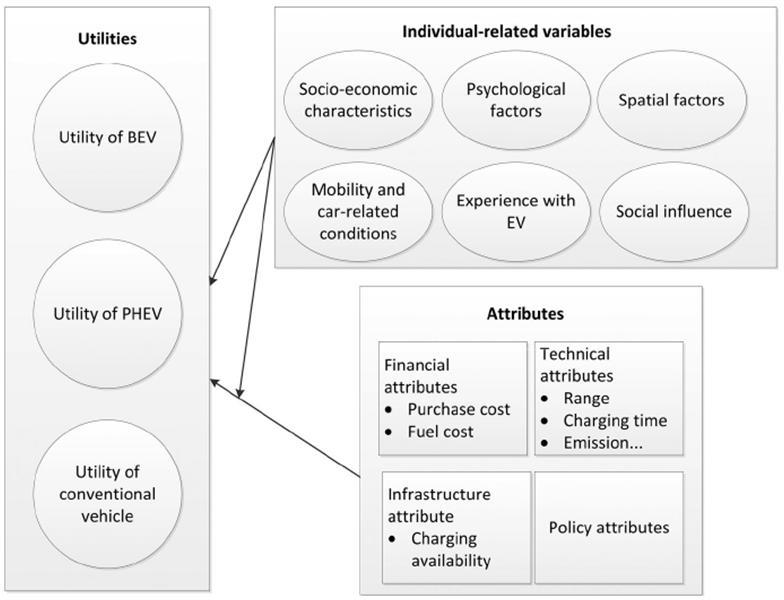
Customer preferences can be grouped into various attributes such as financial, technical and infrastructure, policy, dynamic, socio-economic and demographic characteristics, and psychological theories. Consideration of these attribute is needed when designing the marketing strategy. These attributes are briefly discussed as follows.
Financial, technical and infrastructure attribute: These attributes refer to the direct and indirect costs of owning a Tesla car, the technical specifications, and infrastructure availability. Fig. 2 lists some variables of these attributes.
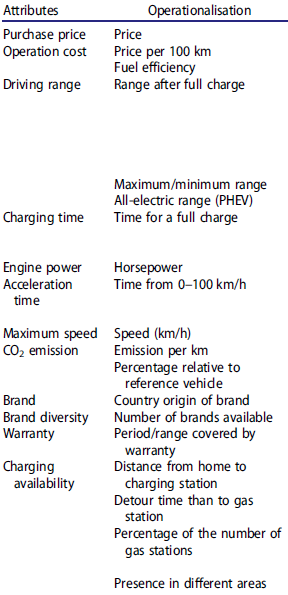
Figure 2 lists some of these attributes and variables. Each customer may give a different weight to the variables. This means that for one customer, the price is very important, while for another, the acceleration time and maximum speed are important. Generally, the price, driving range, top speed, charging points, and charging times are considered most important. One very important aspect is the driving range of a full charge. Users who plan long trips need an assurance that the car would not discharge in the middle of a journey. Tesla specifies that its car can travel about 300 miles on a full charge. In its promotion material, factors like the number of passengers and load carried, uphill and downhill conditions, air conditioning use, etc. are omitted. As a result, a customer may well run out of charge after travelling just 200 miles, becoming stranded and helpless. Tesla must consider these aspects in its marketing strategy (Mabit & Fosgerau 2011).
Brand is very important and automakers such as Audi, Mercedes, BMW, that have decades’ old reputations as reliable brands. Customer awareness of these brands is high, leading to the acceptability of new electric vehicles from these brands. Similarly, brand diversity, or the number of brands and models available, is important. When the market is open and competitive, then brand diversity is high. Tesla faces these barriers in its drive to sell more cars (Hoen & Koetse 2014).
Policy attributes: These refer to different policies, schemes, and concessions that the auto manufacturers and the government announced to promote sales of electric vehicles (Mabit & Fosgerau 2011). Fig. 3 lists some of these policies.
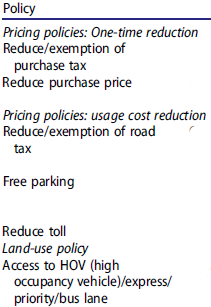
As seen in Figure 3, government policies to promote electric vehicle use include the reduction of purchase taxes or on-road taxes, removing tolls, allowing free parking where available, and allowing single-occupant cars to use high occupancy and priority lanes. Such benefits and policies are a constant reminder of the benefits of electric vehicle use.
Socio-economic, demographic, and psychological attributes and variables: Some of these attributes and variables are explicit and have a significant impact on the buying decisions (Beck, Fifer & Rose 2016). Figure 4 lists some of these variables.
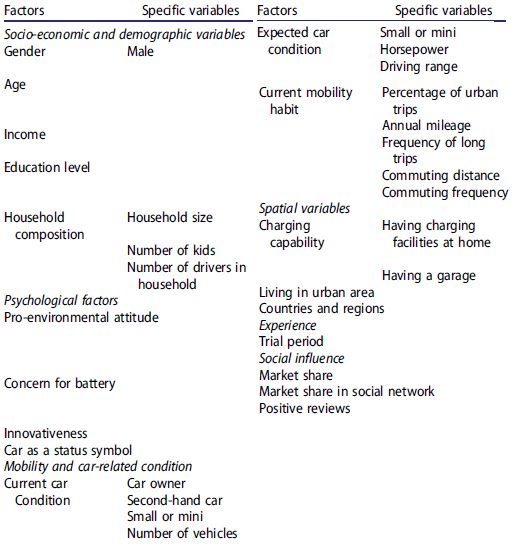
As seen in Figure 4, a large number of factors influence the purchase decision. The number of cars on the road and parking space availability is an important factor. Customers in the suburbs have larger homes and ample spaces to park cars, while those in large cities have limited parking spaces. If a family has a conventional fuel vehicle, then may hesitate before buying another vehicle due to parking restrictions. The size of the existing car is also important and a family-owned a small car would reconsider buying a larger car due to perceived problems in driving (Rasouli & Timmermans 2013).
Bessenbach and Wallrapp (2013) have researched the barriers to purchasing electric vehicles. These include customers’ car involvement, ecological consciousness, EV exposure, bad publicity and adverse media reports, buying incentives, monetary benefits, functional benefits, indirect benefits, and consumer preferences. Therefore, the marketing strategy needs to convey a message that overcomes these barriers.
Theory of Diffusion of Innovation
Tesla vehicles and other electric cars are radical innovations that have the potential to disrupt existing conventional fuel cars. The rate of acceptance or rate of diffusion of these innovations into society must be large enough to ensure the success and sustainability of the brands. The theory of diffusion of innovations, proposed in 1962 by Everett Rogers, explains the process taken to spread innovation in society (Rogers 2003). According to this theory, the following elements can help or hinder diffusion: compatibility, relative advantage, risk, complexity, and trialability. In addition, four elements are important in communicating new ideas: the innovative idea or product, the communication systems and channels, the social system or communities, and time. Product manufacturers want their innovations to spread in society at a rapid rate until a critical mass is reached. In addition, users adopt new innovations at different rates, forming five groups: innovators, early adopters, early majority, late majority, and laggards (Cho, Hwang & Lee 2012). Fig.5 illustrates the model.
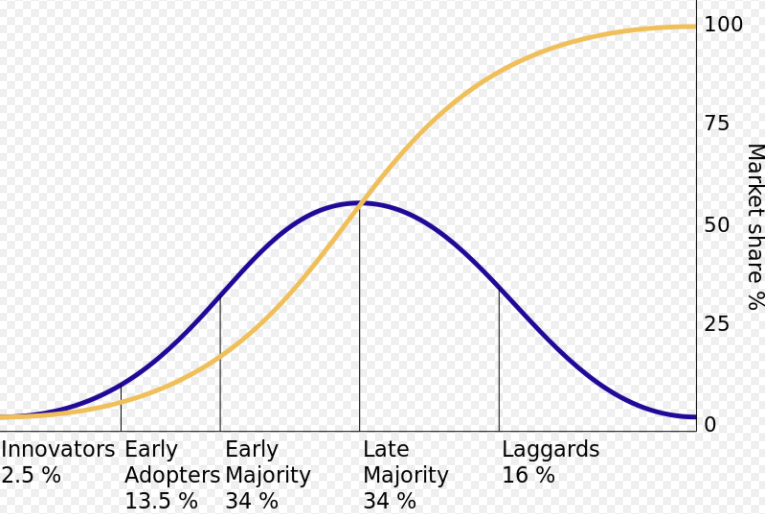
Figure 5 illustrates the division of market share percentage among different users. Adopters are communities, individuals, and businesses, clusters of industries, social networks, and countries that adopt or use a product. The five categories of adopters are briefly described below as they reference Tesla.
Innovators: These are the first users who buy a product as it is introduced in the market. They are risk-takers with financial stability who derive their motivation from being the first users of a product in their social circle; they are driven by the thrill of owning a new product and the associated ‘bragging rights’. Innovators make up 2.5% of the market. In the case of Tesla, innovators were the first group of people who purchased the Model S, launched in 2012. Some innovators sell off their early purchases and buy newer models when available. Tesla must keep in touch with innovators (Higgins et al. 2012).
Early Adopters: These are the next group of users who are opinion leaders. They make up 13.5% of users. They prefer to wait for some time after a product launch before their purchase. These people are more discreet, they judge the options available, have sound financial stability and are ready to take calculated risks. The important characteristic of this category is that it is elastic and community members can influence others to buy a product. Hence, they are social influencers. For Tesla, this group makes up customers for the Model X and the Model 3. Tesla needs to increase the number of members in this category since it is easier to sell to this group (Karakaya, Hidalgo & Nur 2014).
Early Majority: This group of people make up 34% of the market. They have medium risk aversion with restricted financial stability and wait until their acquaintances and members from their social community adopt a product. The length of time waiting before buying a product is longer and they follow opinion leaders. Some percentage of this group can be induced to buy a product if offered the appropriate value proposition. Tesla needs to look at this group to drive sales with appropriate value propositions (Walker, Avellaneda & Berry 2011).
Late Majority and Laggards: These groups make up 34% and 16% of the market, respectively. Members are sceptical of market reports, have less than average social status, lower liquidity, and are prone to view new products with suspicion. A point of importance is that well-off elderly and middle-aged people with sufficient funds fall in this group. They may be unwilling to give up old cars that they drive for many years. Other members may wait until the innovation peaks its lifecycle, watch for price reductions, and then purchase a product when it becomes more affordable. Tesla needs to cover these two groups with occasional communication and keep them ready when lower-priced models are launched in the future (Zhang, Gensler & Garcia 2011).
The assessment from this discussion of diffusion is that Tesla needs to focus on three groups: innovators, early adopters, and the early majority. A maximum number of users would be drawn from these groups, although higher volumes could come from the late majority and laggard groups. It is important to carry out segmentation, positioning, and targeting (STP) studies for these groups.
Marketing Techniques and Methods
As indicated in the previous sections, Tesla cars are innovative and hi-tech products. The cars are premium priced and appeal to specific segments of customers who have a different set of requirements. Some methods of marketing are discussed below.
STP studies: While Tesla has sold more than 450,000 cars, it is important to use its previous sales information to develop segmentation, positioning, and targeting strategies. It appears that Tesla has tapped the innovators and early adopters and it next needs to bring in more people from these groups as well as from the early majority group. Tesla needs to know who these members are, along with their professions, lifestyles, attitudes towards the environment, disposable incomes, etc. The profile of a typical buyer should be created and the marketing strategy should focus on members of this segment (Schlegelmilch 2016).
Marketing mix: The marketing mix extends beyond the standard 4Ps to 7Ps. Today, elements of the marketing mix include product, price, place, promotion, physical evidence, people, and process. The extended marketing mix is needed since the environment where Tesla cars are sold and serviced, the sales and service personnel, and the process of registrations, trial drives, sales, after-sale service, charging points, and the experience of owning a Tesla car are all important. Where possible, Tesla should set up separate charging centres with power supply from solar and wind power (Keller & Kotler 2016).
Marketing channels: These represent channels used for communicating with existing and potential customers. Tesla customers are educated and use social media, the Internet, mobile apps, online publications, TV and other conventional channels. Tesla can increase the use of online media, create separate social media campaigns, and promote memberships. It can also create virtual communities in important cities where Tesla car owners may meet, have drinks, listen to music and entertainment. The focus should be on positioning Tesla as a lifestyle product that is environmentally friendly and helps users to make a fashion statement (Kotler & Armstrong 2013).
IMC methods: Integrated marketing communications are recommended for marketing methods. Consistent messages need to be transmitted through all the marketing channels. The marketing campaign should be monitored to identify channels that bring the maximum returns. Future communications can then focus on these channels (Belch et al. 2014).
Summary
This section reviewed the literature on electric vehicles, presented an analysis of the macro forces, micro forces, and the strength of entry barriers. The market for Tesla vehicles has shown strong growth, and while the competition is high, Tesla can build on its product and brand strengths to increase sales. The theory of diffusion applied to Tesla makes it clear that the firm needs to focus on innovators, early adopters, and the early majority. Some potential marketing methods that would help Tesla are STP studies, developing an appropriate marketing mix and implementing marketing messages using online and traditional channels using IMC.
Methodology
The intention of the research is to find methods and processes for effective advertising strategies for Tesla. As mentioned in the initial chapters, Tesla faces an immediate urgency to bring in focused advertising to increase sales. Answers or solutions to this problem will be derived by using a mixed-methods approach. In this method, a literature review will help to find out past methods used by technology firms in delivering innovative products. Several attributes that affect electric vehicle purchase decision and their variables will also be identified. While examples of Apple’s iPad and other technology devices come to the mind, these are not suitable comparisons, since an Apple X phone costs about $1000, while a Tesla Model S costs more than $100,000.
Therefore, customers’ level of commitment and decision-making regarding Tesla products are more intensive due to the high cost of the product. This proposal is for a multi-method approach. First is secondary research to analyse and assess marketing methods and processes, and to identify important attributes and variables. Then, these findings will be used to design two survey instruments to conduct primary research. Respondents for the first instrument will include existing owners of Tesla and potential customers. The second instrument will be a semi-structured survey instrument and respondents will be managers of large car dealerships. Findings from these three methods will be triangulated to obtain a concise set of findings. These findings will form the basis for recommendations of the marketing strategy for Tesla (Smith 2015). Figure 3 illustrates the research model.
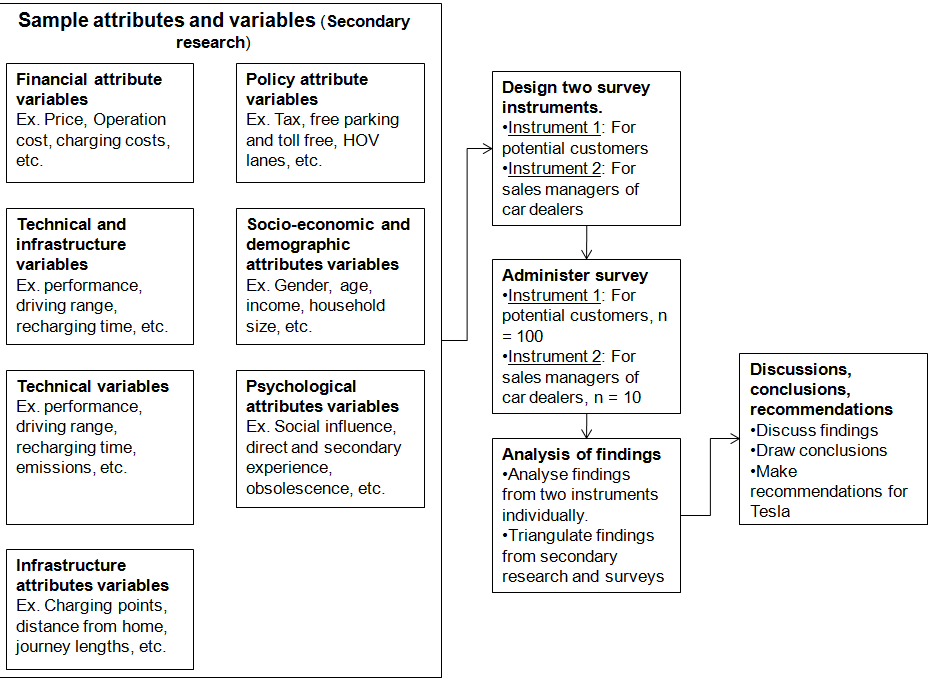
Research questions
The following research questions are proposed.
What marketing strategies and methods are suitable for Tesla to increase sales rapidly?
What factors act as motivators, drivers, and inhibitors in Tesla achieving high growth?
Aims and Objectives
The aim of the research is to determine the marketing strategies and channels that are most suitable to sell Tesla cars and help the firm to survive.
The objectives of the research are as follows:
- Carry out STP studies to identify the appropriate segments, target these segments, and develop a positioning strategy with a USP.
- Research and suggest integrated marketing strategies for the selected segments.
- Evaluate and select marketing channels and modes to deliver advertising content and promotion strategies.
- Develop a time-bound plan with indicative costs to implement these strategies.
Research Philosophy
The research philosophy requires adopting a structured path to gain knowledge and define the reason for the research. It helps to answer questions on the research subject, the methods used in the research and the reasons for the research. The research philosophy specifies the set of values, beliefs, and assumptions considered for the research (Saunders 2011). Important philosophies available are pragmatism, realism, positivism, and objectivism. Among these, the positivist method is used in this research to study the various issues in the research. The positivist philosophy uses logical deduction and observations of an event and assesses them to understand relations between different entities. Data gathering tools, such as surveys, are used in the research. This research will use a positivist philosophy since the objective is to find a suitable marketing strategy for Tesla (Bryman & Bell 2015).
Research Approach
The research approach is the formal and structured method used to develop knowledge for the research through a set of assumptions. Two types of approaches are available namely, deductive and inductive. The deductive approach, also called the ‘top-down’ approach, makes observations of a phenomenon through observation or surveys. Using findings from these observations, important points and issues are drawn that reveals the nature of the event, and appropriate recommendations are made. The inductive approach, or ‘bottom-up’ approach, develops a set of hypotheses about an event. These hypotheses are tested through a survey instrument or through secondary research and data is analysed with statistical analysis tools, such as SPSS. A review of both approaches indicates that the deductive method is suited for this research since we do not know already about the marketing methods of Tesla. The survey instrument will elicit responses from the respondents and develop conclusions and recommendations (Sekaran & Bougie 2016).
Two other important approaches relevant to academic research are qualitative and quantitative methods. The qualitative method is not complex and it uses responses through contextual analysis and with simple Excel calculations. Data gathered is simple and variablesand their relations are not examined. The qualitative method uses simplistic surveys with basic Likert score questions, and close-ended questions, with multiple options. Respondents select one or more options and create a spectrum of responses. These responses are analysed with keyword associations or simple data analysis and conclusions are drawn to answer the research question. The qualitative approach is used along with the positivist approach. Quantitative research is more complex and is carried out by drawing hypotheses, identifying variables and using surveys to obtain responses. This research uses simple survey instruments, where respondents generate simplistic data through responses. Hence, the qualitative method is used in this research (Zikmund et al. 2013).
Research Strategy
Research strategy defines the methods used in collating research data. The strategy includes methods of selecting respondents and data analysis methods. Different methods available for data gathering include surveys, semi-structured interviews, grounded theory, action research, archival research and case studies, among others. For this research, surveys and semi-structured methods are proposed.They help to obtain views of respondents to a set of similar questions. The survey instrument will have a set of research questions with multiple option selections and single option selections, and a few questions based on theLikert score. Respondents will select the options according to their perspective. The semi-structured instrument has a set of open-ended questions, to which respondents give their options and views (Fowler 2013).
Research Design
For this study, two survey instruments are proposed. The first instrument is for potential customers of Tesla cars and the second is for managers of automobile dealerships. These instruments will be designed when the full research is undertaken. Sample instruments are given below. The number of questions will be expanded and modified when the full research is undertaken.
Table 1. Sample survey questions for potential Tesla customers.
Given below are sample questions for the semi-structured interviews.
Table 2. Sample semi-structured interview questions.
Population and Sampling
Two sets of survey instruments are proposed. Details of the population and sampling are given as follows.
Instrument 1: Considering that Tesla will have thousands of customers, according to Saunders (2011), the research sample must cover 318 individuals to obtain a meaningful representation. Since the author of this research has limited resources, a sample population of 100 is considered. Respondents will be affluent business owners, entrepreneurs and executives, who are interested in protecting the environment and who have sufficient funds (Patten & Newhart 2017).
Instrument 2: These respondents will include store managers of car dealerships of brands such as Audi, Mercedes, BMW, Ford, etc. The proposal is to approach 10 dealers and ask managers to respond (Saunders 2011).
Data Collection
The survey instruments will be mailed to the two sets of respondents with a request to complete and mail them back. Emails and contact details will be obtained. Another possibility is to host Instrument 1 on Survey Monkey and send a link to respondents (Taylor, Bogdan & DeVault 2015).
Data Analysis
Data analysis of Instrument 1 will be done by calculating the number of responses that each option for each question receives. The percentage of responses will be calculated to decide the majority perspective. For Instrument 2, keywords for each question will be extracted and analysed contextually (Ritchie et al. 2013).
Timelines
The following Gantt chart gives the project timelines for each major activity.
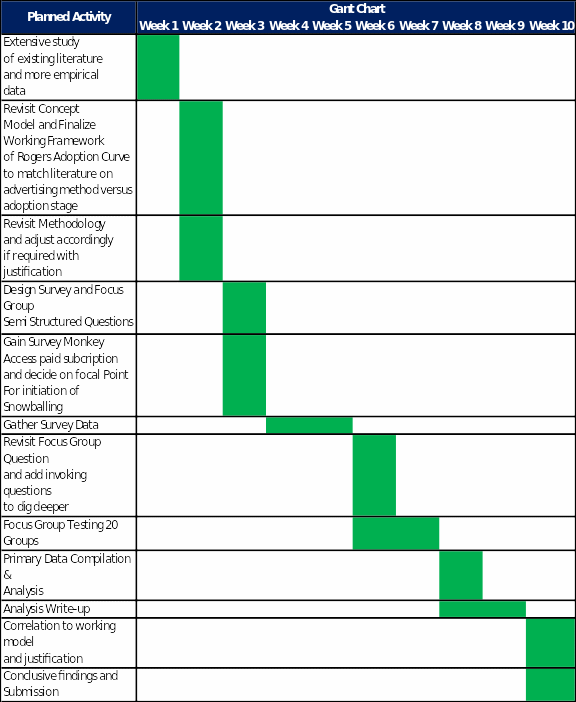
Resource Plan
A survey monkey subscription requires afee payment, which will be less than 100 USD for the duration of the 10-week project. Other resources include time, reading materials and books. These can be accessed from the academic library, the Internet and past readings on marketing at college, university and from current academic pursuits.
Conclusions
The assessment is that Tesla can survive and grow in the market by using aggressive marketing strategies. While the market sees many auto firms offering electric cars, Tesla can use its strong brand identity and high-performance cars to dominate the market. Certain research questions and objectives have been framed in this proposal. These will be answered by using two survey instruments. The recommendation is that a full research study can be conducted to develop marketing methods for Tesla.
Reference List
Barney, JB 2014, ‘How marketing scholars might help address issues in resource-based theory’, Journal of the Academy of Marketing Science, vol. 42, no. 1, pp.24-26.
Barry, B 2017. Tesla Model X vs. Audi Q7 vs. Range Rover Sport triple test review. Web.
Bartlett, JS 2017. Which car brands make the best vehicles. Web.
Beck, MJ, Fifer, S & Rose, JM 2016, ‘Can you ever be certain? Reducing hypothetical bias in stated choice experiments via respondent reported choice certainty’, Transportation Research Part B: Methodological, vol. 89, no. 6, pp. 149–167.
Belch, GE, Belch, MA, Kerr, GF & Powell, I 2014, Advertising: an integrated marketing communication perspective, McGraw-Hill Education, London.
Bessenbach, N & Wallrapp, S 2013. Why do consumers resist buying electric vehicles, Dissertation for M.Sc., Copenhagen Business School, Copenhagen.
Bryman, A & Bell, E 2015. Business research methods, Oxford University Press, New York, NY.
Car & Driver 2017. Tesla models and specifications. Web.
Cazzola, P 2017. Global EV outlook 2017. Web.
Cho, Y, Hwang, J, & Lee, D 2012, ‘Identification of effective opinion leaders in the diffusion of technological innovation: a social network approach’, Technological Forecasting and Social Change, vol. 79, no. 1, pp.97-106.
Fowler, FJ 2013, Survey research methods, Sage Publications, London.
Hackbarth, A & Madlener, R 2013, ‘Consumer preferences for alternative fuel vehicles: a discrete choice analysis’, Transportation Research Part D: Transport and Environment, vol. 25, no. 5, pp. 5–17.
Higgins, A, Paevere, P, Gardner, J & Quezada, G 2012, ‘Combining choice modelling and multi-criteria analysis for technology diffusion: an application to the uptake of electric vehicles’, Technological Forecasting and Social Change, vol. 79, no. 8, pp.1399-1412.
Hoen, A, & Koetse, M J 2014, ‘A choice experiment on alternative fuel vehicle preferences of private car owners in the Netherlands’, Transportation Research Part A: Policy and Practice, vol. 61, no. 9, pp. 199–215.
Hollensen, S 2015, Marketing management: a relationship approach, Pearson Education, London.
Holtsmark, B, & Skonhoft, A2014, ‘The Norwegian support and subsidy policy of electric cars: should it be adopted by other countries?’,Environmental Science & Policy, vol. 42, no. 4, pp. 160–168.
Jones, C 2017, Deutsche Bank’s 2018 breakeven cash flow projection for Tesla doesn’t pencil out. Web.
Kane, L 2017, Tesla has delivered more than 250,000 EVs, ~55% in the U.S. Web.
Karakaya, E, Hidalgo, A & Nur, C 2014, ‘Diffusion of eco-innovations: a review’, Renewable and Sustainable Energy Reviews, vol. 33, pp.392-399.
Keller, KL & Kotler, P 2016, Marketing management, Pearson, London.
Kim, J, Rasouli, S, & Timmermans, H 2014, ‘Expanding scope of hybrid choice models allowing for mixture of social influences and latent attitudes: application to intended purchase of electric cars,’ Transportation Research Part A: Policy and Practice, vol. 69, no. 5, pp. 71–85.
Kotler, P & Armstrong, G 2013, Principles of marketing, 16thedn, Pearson, London.
Lambert, F 2017. Tesla to break even on Model 3 at $41,000, says UBS based on cost analysis of Chevy Bolt EV. Web.
Liao, F, Molin, E & Wee, B 2017, ‘Consumer preferences for electric vehicles: a literature review’, Transport Reviews, vol. 37, no. 3, pp. 252-275.
Mabit, S L, & Fosgerau, M 2011, ‘Demand for alternative-fuel vehicles when registration taxes are high’, Transportation Research Part D: Transport and Environment, vol. 16, no. 3, pp. 225–231.
Models 2017, Tesla Model 3 and Model X, Web.
Patten, ML & Newhart, M 2017, Understanding research methods: an overview of the essentials, Taylor & Francis, London.
Petschnig, M, Heidenreich, S& Spieth, P 2014, ‘Innovative alternatives take action – investigating determinants of alternative fuel vehicle adoption’, Transportation Research Part A: Policy and Practice, vol. 61, pp. 68–83.
Porter, ME & Heppelmann, JE 2015, ‘How smart, connected products are transforming companies’, Harvard Business Review, vol. 93, no. 10, pp. 96-114.
Rasouli, S, & Timmermans, H 2013, ‘Influence of social networks on latent choice of electric cars: a mixed logit specification using experimental design data’, Networks and Spatial Economics, vol. 13, no. 9, pp. 1–32.
Ritchie, J, Lewis, J, Nicholls, CM & Ormston, R 2013, Qualitative research practice: a guide for social science students and researchers, Sage, London.
Rogers, E 2003, Diffusion of innovations, 5th edn, Simon and Schuster, New York, NY.
Saunders, MN 2011, Research methods for business students, 5th edn, Pearson Education, New York, NY.
Schlegelmilch, BB 2016, Segmenting, targeting and positioning in global markets: in global marketing strategy, Springer International Publishing, Berlin.
Sekaran, U & Bougie, R 2016, Research methods for business: a skill building approach, John Wiley & Sons, London.
Singer, M 2016. Consumer views on plug-in electric vehicles – national benchmark report. Web.
Smith, JA 2015. Qualitative psychology: a practical guide to research methods, Sage, London.
Statista 2017. U.S. automotive industry – statistics & facts. Web.
Taylor, SJ, Bogdan, R & DeVault, M 2015, Introduction to qualitative research methods: a guidebook and resource, John Wiley & Sons, London.
Tesla 2017, Tesla Models, Web.
Valeri, E, & Danielis, R 2015, ‘Simulating the market penetration of cars with alternative fuel powertrain technologies in Italy’, Transport Policy, vol. 37, no. 10, pp. 44–56.
Walker, RM, Avellaneda, CN & Berry, FS 2011, ‘Exploring the diffusion of innovation among high and low innovative localities: a test of the Berry and Berry model’, Public Management Review, vol. 13, no. 1, pp.95-125.
Wood, E 2017. National plug-in electric vehicle infrastructure analysis. Web.
Zhang, T, Gensler, S & Garcia, R 2011, ‘A study of the diffusion of alternative fuel vehicles: an agent‐based modelling approach’, Journal of Product Innovation Management, vol. 28, no. 2, pp.152-168.
Ziegler, A 2012, ‘Individual characteristics and stated preferences for alternative energy sources and propulsion technologies in vehicles: a discrete choice analysis for Germany’, Transportation Research Part A: Policy and Practice, vol. 46, no. 8, pp. 1372–1385.
Zikmund, WG, Babin, BJ, Carr, JC & Griffin, M 2013, Business research methods, Cengage Learning, London.
